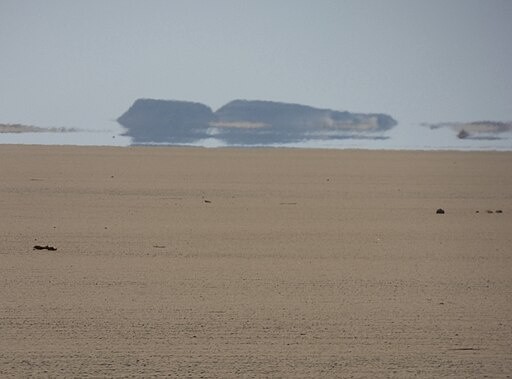You might notice water on the road ahead while driving on a hot summer day. You go farther, yet you don't get closer to the perceived wet pavement. That is because what looks like water is not water at all but a mirage.

A mirage can also be seen on the hot sand at the beach and in the desert, where it is often depicted as a lush oasis. However, this phenomenon does not have anything to do with water but is about how light travels through air.
How Does Light Travel Through Air?
Light travels in a straight line when the air is the same temperature, either constant hot or cold. If there is a steady variation in temperature, light will refract and bend towards the cooler air.
Since cold air is denser than warm air, it has a higher refractive index, where light will bend more easily. Because the particles of light bump into more matter, they slow down and turn. As it travels from hot to cold air, the light tendswards a parallel line to the medium boundary. Similarly, when light passes from cold to hot air, it bends away from this line.
What Causes a Mirage?
A mirage is an optical effect created when light bends while passing through different air densities. Normally, light waves from the Sun travel straight through the atmosphere to human eyes.
Mirages occur when the ground is very hot while the air is cool. The hot ground warms a layer of air just above the ground. When the light moves through the cold air and into the layer of hot air, it gets refracted.
The light from the sky is refracted by a layer of hot air near the ground into a U-shaped bend. Meanwhile, the brain does not see the image as bent light from the sky. Instead, it thinks the light has traveled in a straight line, assuming it must have come from something on the ground.
In other words, our brain plays a trick on us as it believes that the refracted light follows a straight path. As a result, we follow the light back to the source, which appears to be the ground. When all of these factors are combined, the refracted light from the sky is interpreted as straight, letting our eyes see an image of the sky on the ground.
The case of a road looking wet is known as an inferior mirage. This wet road illusion starts with the asphalt road absorbing thermal energy from the Sun and becoming hot. The hot road heats the air directly above it, making it less dense. The atmosphere is much more relaxed and denser, just a few feet higher. As a result, the light from the Sun is bent or refracted towards your eyes as it travels through various densities, giving the illusion of a wet pavement.
There is also a superior mirage, which happens when colder air is present below warmer air. This mirage gives the illusion of objects lifted into the sky, like a city in the distance or a boat floating in mid-air. It is common in snow-covered ground or a very cold body of water.
RELATED ARTICLE : Water On South Pole Of Mars Is Just A Dirty Mirage, Study Says
Check out more news and information on Mirage in Science Times.
© 2026 ScienceTimes.com All rights reserved. Do not reproduce without permission. The window to the world of Science Times.












